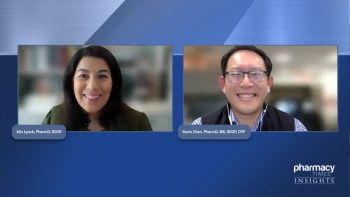
RSV Vaccines for the Adult Patient
A panel of experts discuss RSV vaccination in adults.
Episodes in this series

Ryan Haumschild, PharmD, MS, MBA: As many of you have mentioned good news is on the horizon. We are starting to have FDA-approved RSV [respiratory syncytial virus] vaccines, and more than 1. In the past we’ve been chasing this symptomatic illness and trying to prevent it. But now, Dr Welch, how will these vaccines protect adults against RSV infections moving forward?
Adam C. Welch, PharmD, MBA, FAPhA: The FDA is a really exciting pipeline here. First of all, it’s very robust. There are a lot of RSV vaccine candidates coming through the pipeline that are in phase 2 and phase 3 trials. But the FDA recently approved 1 in older adults. And the FDA committee on vaccines also voted to approve 1 for maternal health. There are actually 3 buckets targeting RSV. One, we have older adults, so 60 and older. We have pregnant women, so second or third trimester. Think obstetrics and the whole other line of care. And then we have infants. So by vaccinating the moms while they’re pregnant, we’re trying to provide those passive antibodies to the infants for the first 6 months of their life to help prevent that first RSV season. But the FDA recently approved the vaccine for ages 60 and older. Now, as we’re filming this, the CDC [Centers for Disease Control and Prevention] has yet to meet for that, but they’re expecting to meet in the summer of 2023 to discuss the recommendations for this vaccine. The vaccine is called Arexvy. It’s an RSV prefusion protein-based vaccine. It’s going to look very similar to some other vaccine. It’s a half a milliliter dose that you would give in the muscle, intramuscularly, in the deltoid. It’s going to come in 2 different vials. One vial will contain the active ingredient; the other one will contain an adjuvant. So the 2 will need to be reconstituted. Once you reconstitute it, you’ll have about 4 hours to administer the dose. Both of those vials prior to reconstitution will be stored in the refrigerator. The adjuvant of the vaccine that’s approved is the same adjuvant that’s in the shingles vaccine, but at half the concentration, half the dose. So a little bit of familiarity I think for some community pharmacists as far as the mixing, storage, and handling of this vaccine. It’s FDA-approved for adults 60 and older. Now the CDC has talked about making recommendations for 65 and older or for 60 and older. They haven’t voted yet as of today, as of this filming. We’ll have to wait and see because it’s a rapidly evolving landscape here, both with new products coming out and with what’s already available.
Ryan Haumschild, PharmD, MS, MBA: You touched on it when you were discussing the vaccine. But if you could, as you mentioned, a lot of community pharmacies are going to be on the front lines helping get patients vaccinated, but they need to be familiar with the product more uniquely. You talked about some of it involves reconstitution and refrigeration. If you had a couple of key takeaways for the pharmacists that are watching this exchange, what would they be regarding preparing the product?
Adam C. Welch, PharmD, MBA, FAPhA: This product again, with RSV, we’re thinking during the flu season typically. Now we know COVID-19 has disrupted some of that peak time. We’re looking at influenza that time of year. We’re looking at potentially RSV vaccines that time of year. So we’re going to see a significant portion of the population, the older population, come into a pharmacy to get their influenza vaccine. We can use that opportunity to also provide the RSV vaccine. People ask, well can they just put it all together into 1 shot? Not yet. No. We don’t have that available. So it will be 2 different vaccines. Pharmacists are going to have to manage that aspect of it. But mixing 2 different vials together to create the vaccine is not something new for community pharmacists. And it’s a refrigerated vaccine, so we’re not going to deal with some of the deep storage issues that we had with COVID-19 and some of those stringent requirements. It will be somewhat familiar from that regard as far as the storage and handling. An intramuscular injection at half a milliliter is kind of familiar for pharmacies and pharmacists to administer. As it stands right now, if they needed flu and RSV for this upcoming flu season, assuming the CDC has affirmed its recommendations, 1 injection in each arm of the deltoid would be appropriate for this prevention.
Christina Madison, PharmD, FCCP, AAHIVP: I just want to also echo the sentiment around maximizing that appointment to not have a missed opportunity to vaccinate. So really talking about the ability to do simultaneous vaccination administration by utilizing 2 anatomic sites because I know that that was something that was a bit of a debate prior, but you are only limited to the amount of arm and leg space that you have. You can definitely give more than 1 vaccine at a time. So please make sure if you’re listening at home, I know that that’s something that comes up quite often. And I do want to make sure that people know that you can absolutely do that at the same time. And just make sure that people know what aftercare they can do to lessen some of those injection site pain and reaction.
Adam C. Welch, PharmD, MBA, FAPhA: There’s a huge opportunity for these age-based vaccine recommendations. A 60- or 65-year-old comes in, we can think shingles. We can think pneumococcal. We can think influenza. Some of the higher dose or the adjuvant, some of the enhanced influenzas in RSV. So that target group, based around the age-based recommendation, [is a] huge opportunity for community pharmacists to impact that area.
Christina Madison, PharmD, FCCP, AAHIVP: I also just wanted to give a plug for our technician colleagues and our trainees as well. This is a fantastic opportunity to utilize that portion of our workforce because they can help with that preparation. And then we can do some of the more like deep dive around the clinical aspect where we’re actually checking to see that we’re not having a missed opportunity to vaccinate. We are doing that ability to go through and do a vaccine audit and make sure that the patient is up to date as possible. I do think making sure that we’re utilizing those colleagues for their skillset so that we can do our best ability to make sure the patient has the best patient care possible.
Ryan Haumschild, PharmD, MS, MBA: I think providers educating patients on possibly getting both of them at the same time is going to be good for them and it’s going to allow them to stay on their vaccine schedule. It’s important, whether they get the vaccine in clinic with a provider or whether they get referred to a community pharmacy, having that expectation is definitely a good thing. And I know we’re looking at that moving forward even with COVID-19, flu, and now RSV being welcomed into the space.
Transcript edited for clarity.
Newsletter
Stay informed on drug updates, treatment guidelines, and pharmacy practice trends—subscribe to Pharmacy Times for weekly clinical insights.












































































































































































































